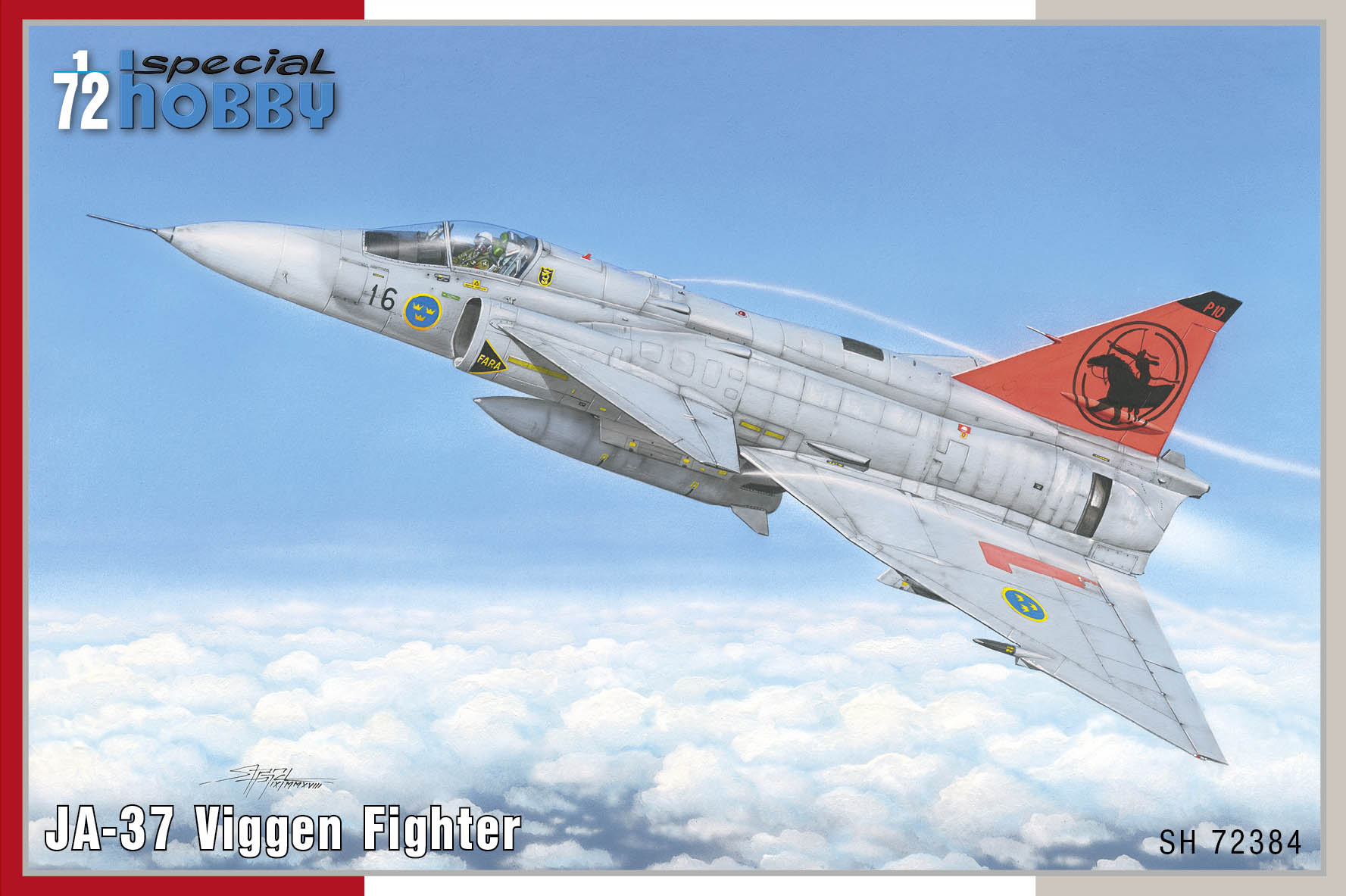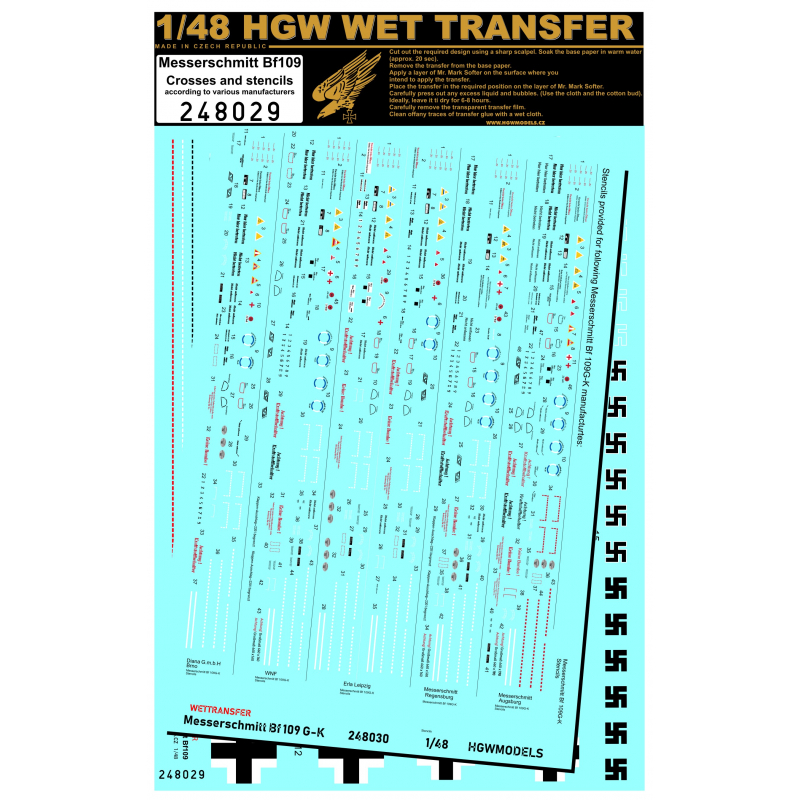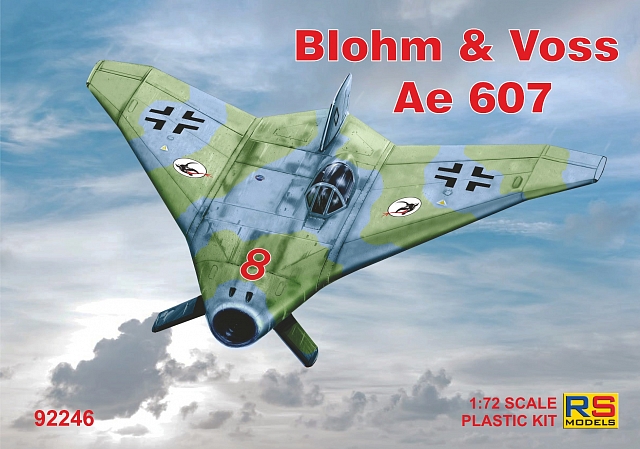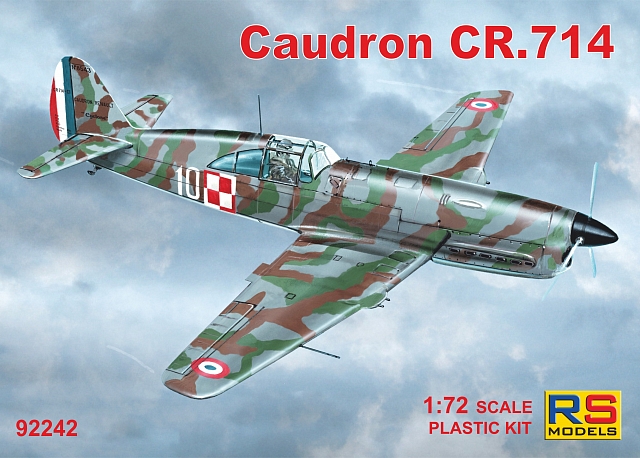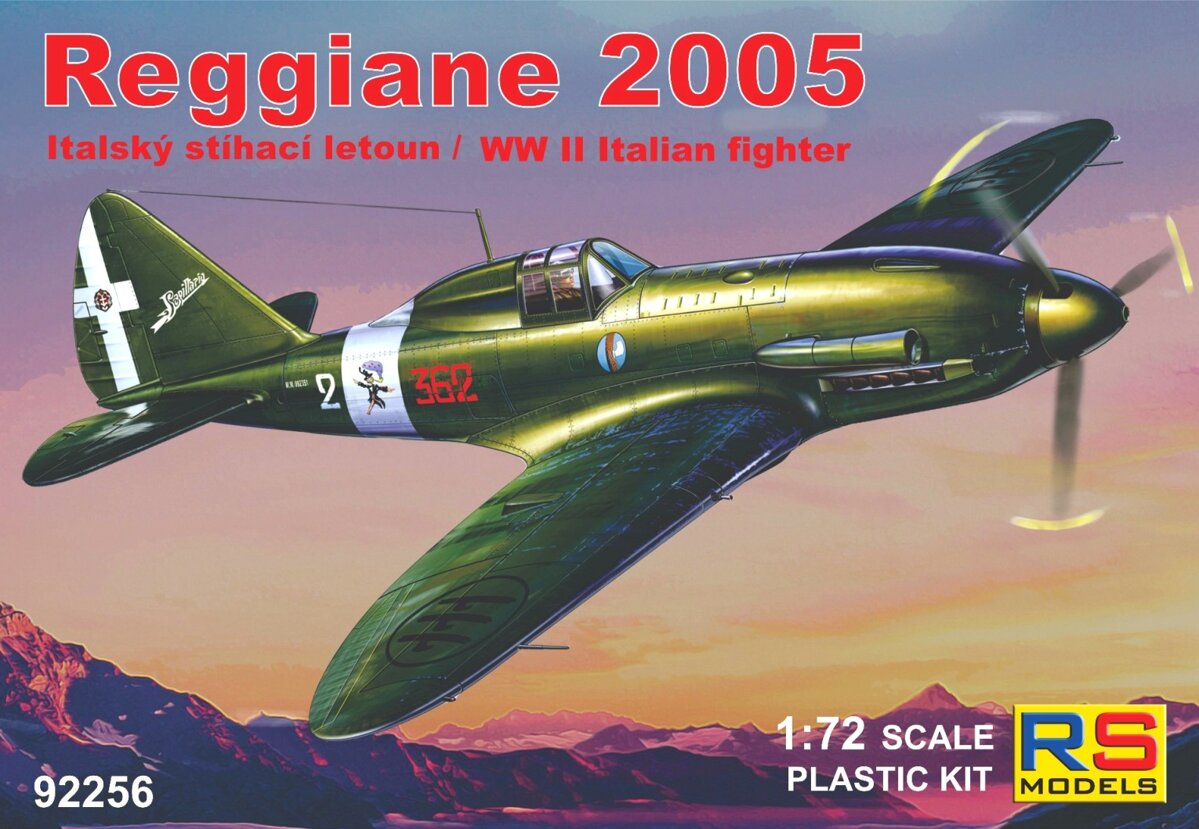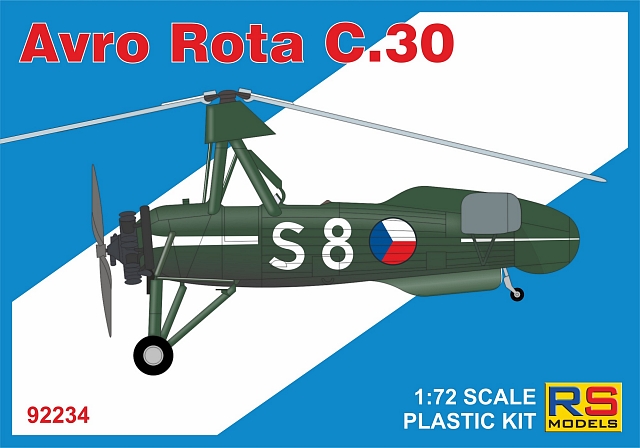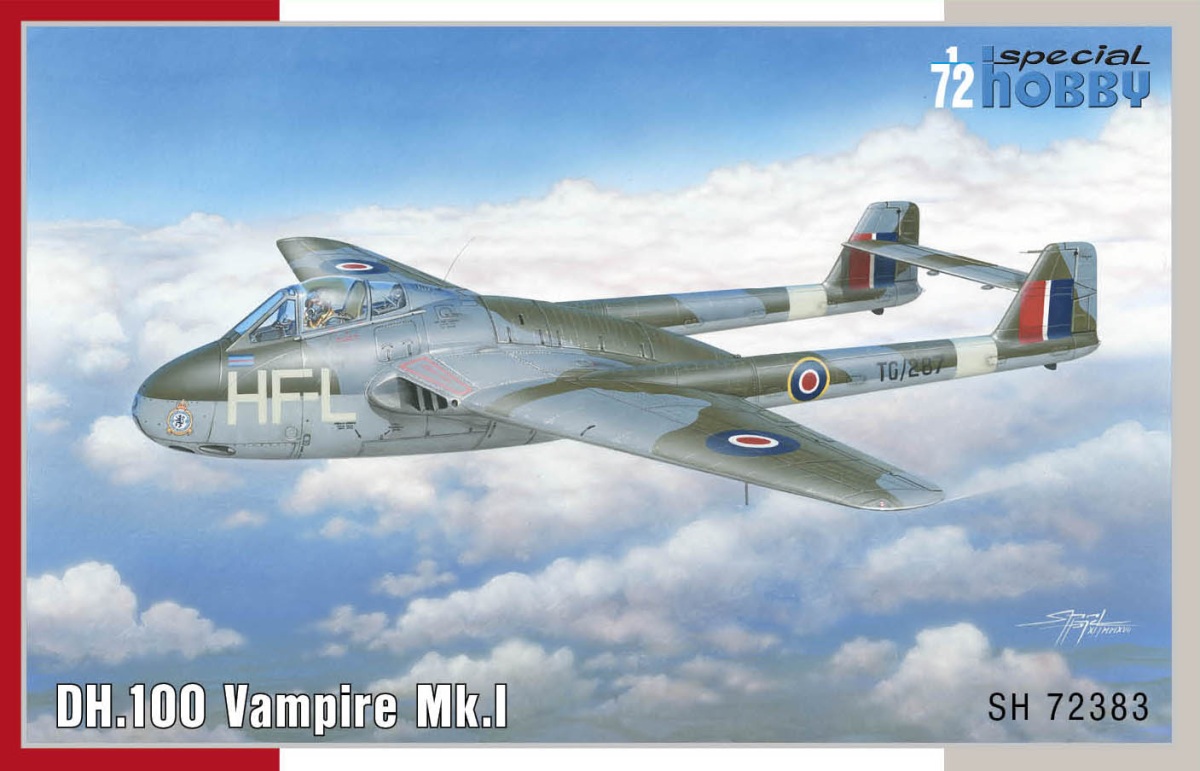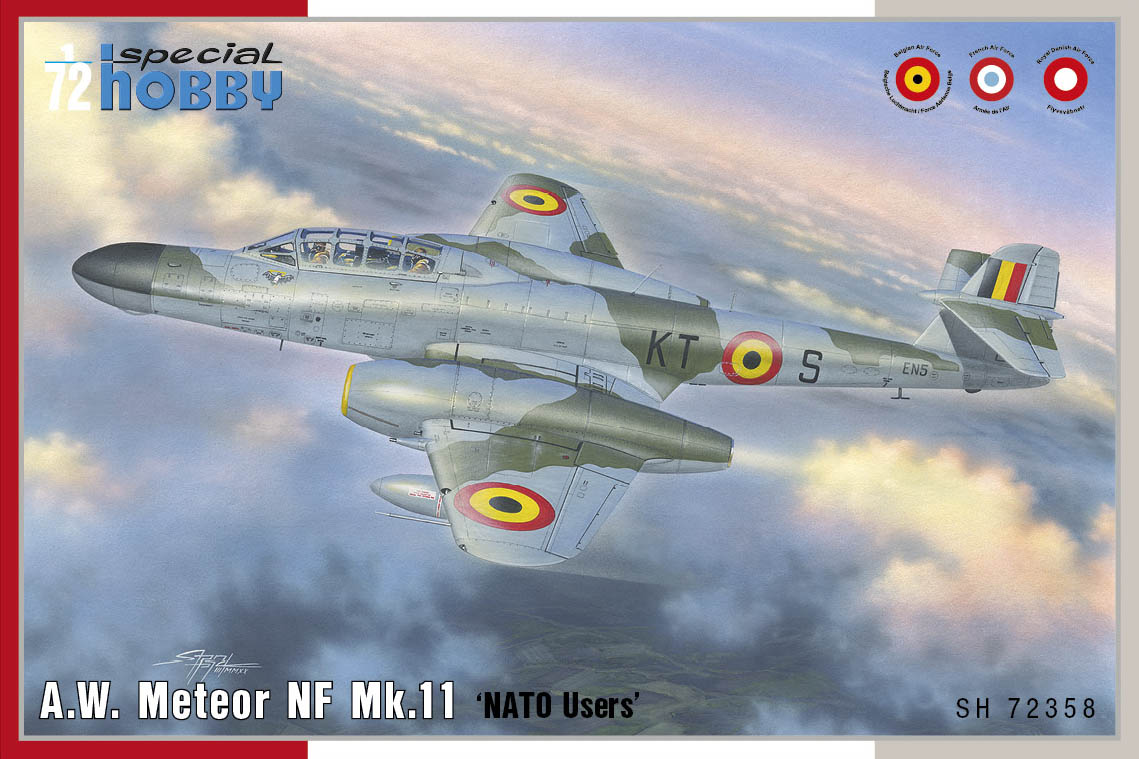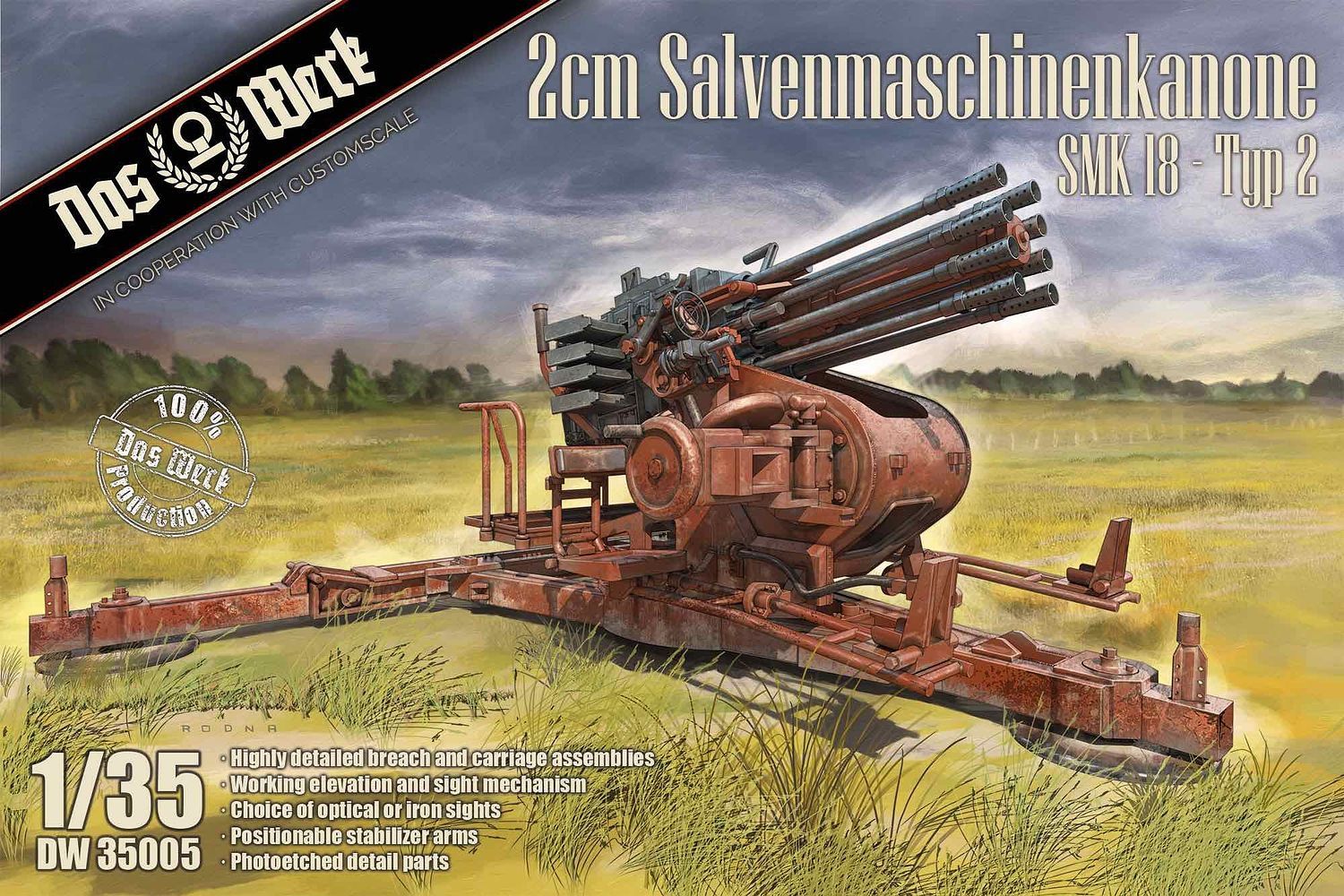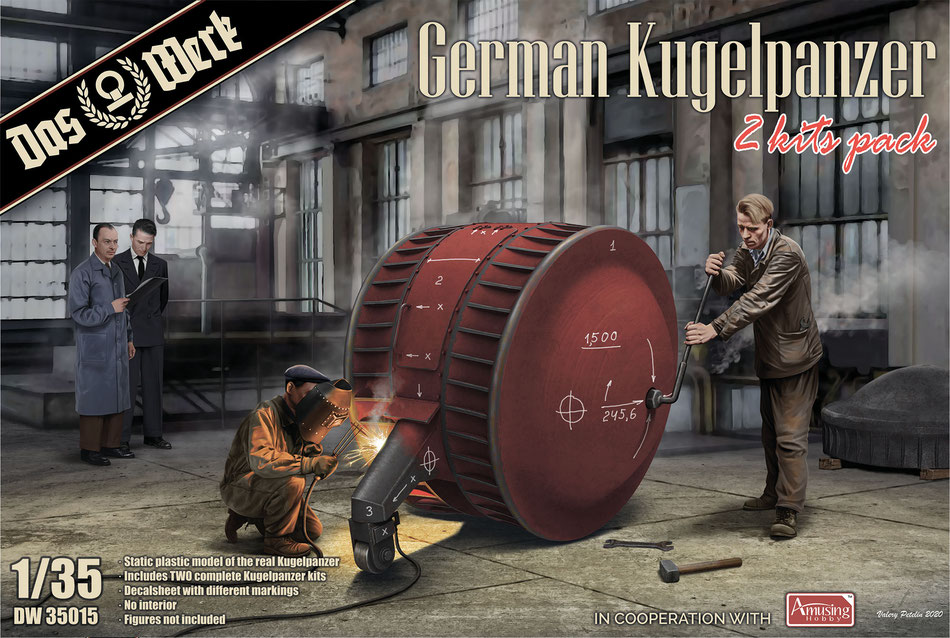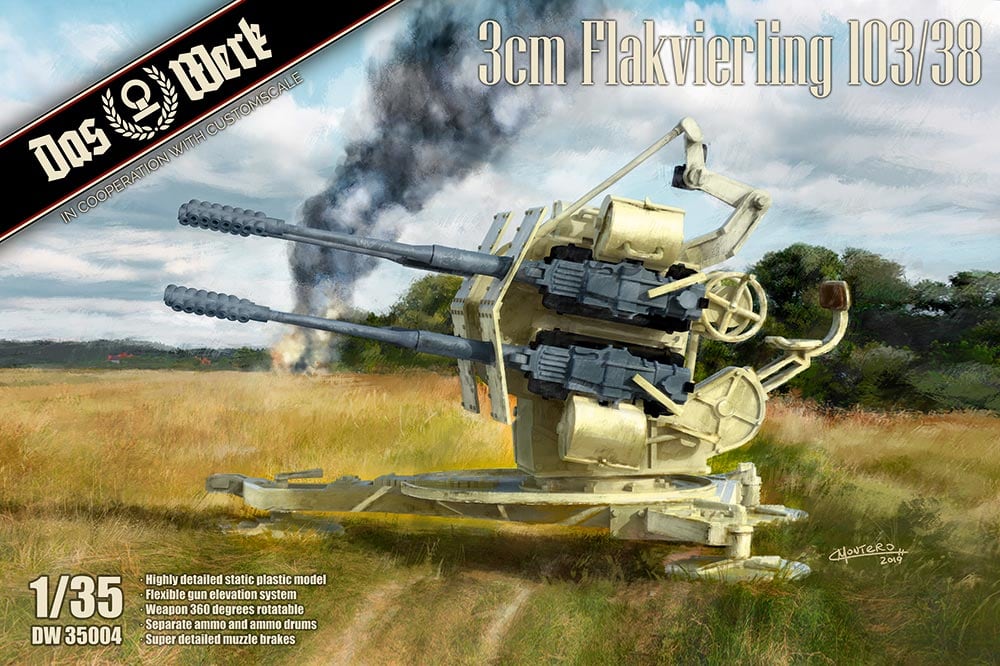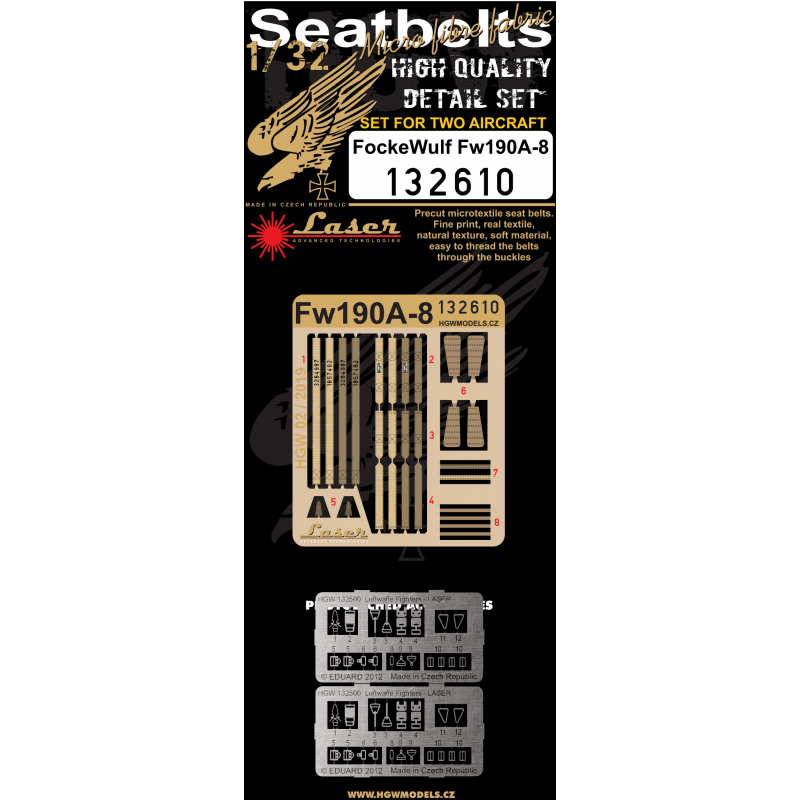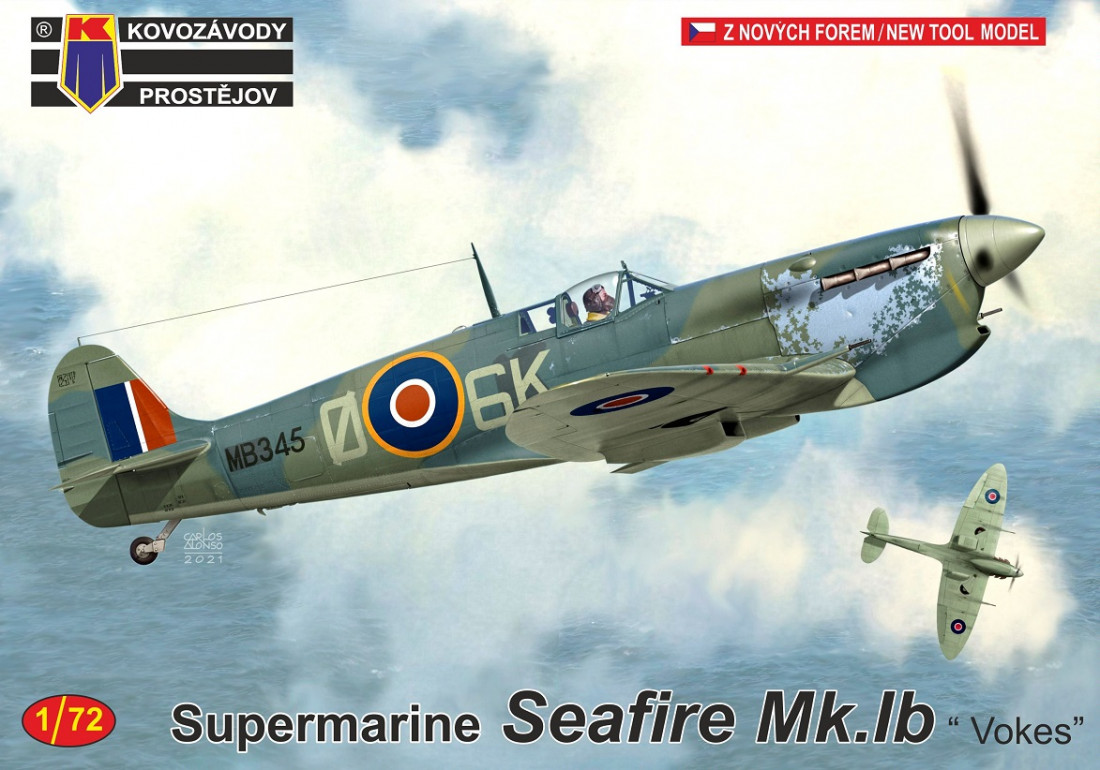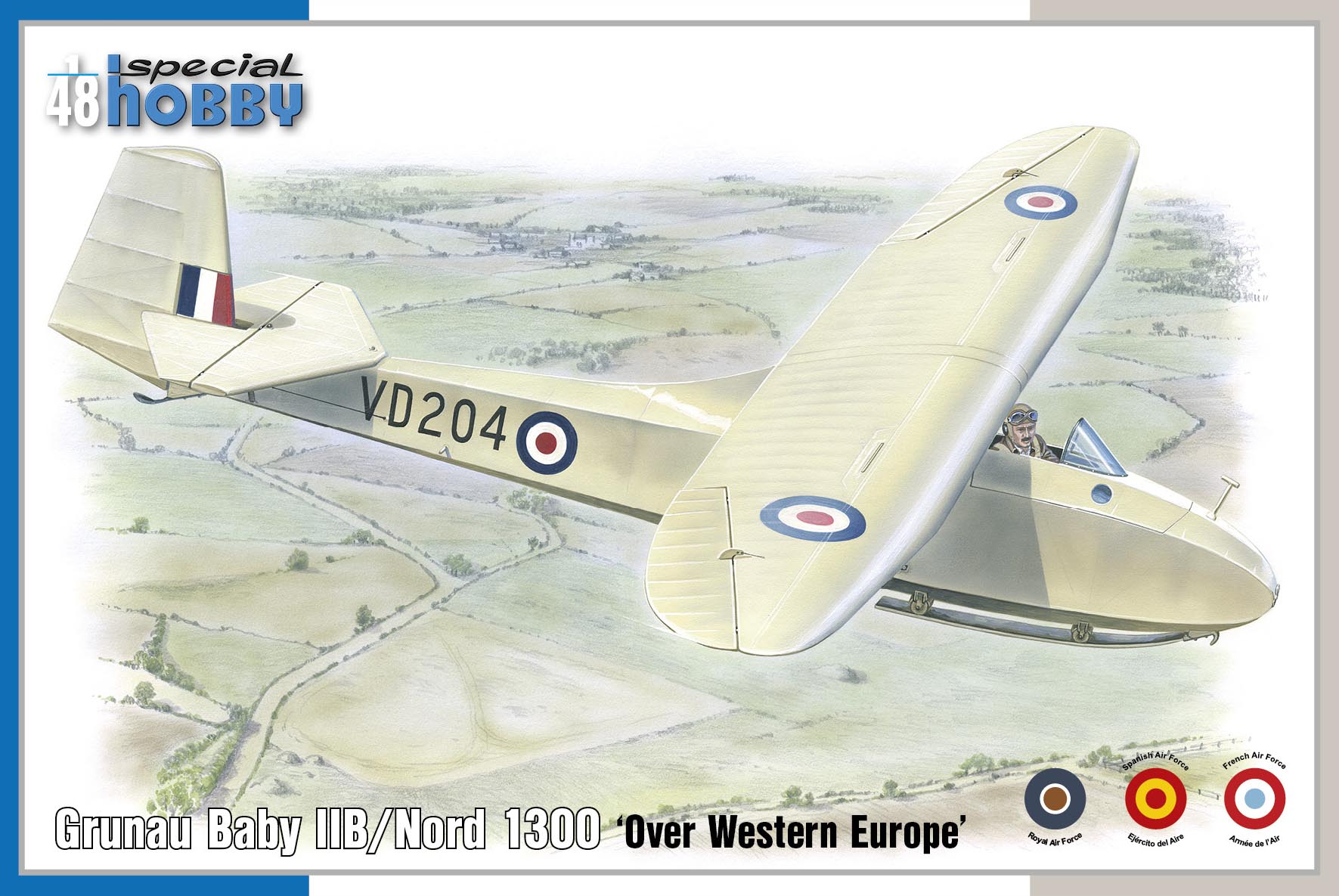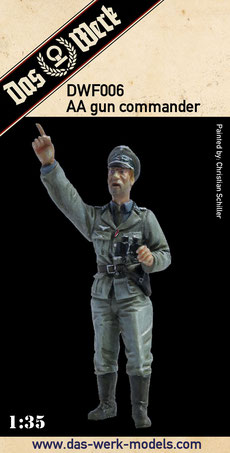Hračky
Celkem 304 produktů
Plastikový model letadla 1/72 JA-37 Viggen. Model of the second generation of the Viggen fighter aircraft which featured longer fuselage and more powerful engine. Content of the kit: eight parts on styrene sprues, one clear styrene sprue, full colour instruction booklet, a sheet of decals highly accurate and finely detailed model, the top notch 1/72 Viggen currently on the market decals cater for three machines one of which sports eyecatching anniversary scheme with red tail fin and a rider on it. wide range of detail sets and figures with ladders available. Country of origin: Sweden / modern
1/48 Tempest Mk.V Series 1 . Stavebnice britského druhoválečného stíhacího letounu Tempest Mk.V Series 1 v měřítku 1/48, edice Weekend. Ze stavebnice je možné si postavit stroje účastnící se operace Overlord. plastové díly: Eduard počet kamuflážních schémat: 2 obtisky: Eduard leptané díly: ne maska: ne Kamuflážní schémata: A) JN751, Wg Cdr Roland P. Beamont, 150. Wing, Newchurch, Velká Británie, červen 1944 V květnu 1944 byl 150. Wing uznán operačním, Tempesty byla vyzbrojena pouze 3. a 486. squadrona, zatímco 56. squadrona si na nové Tempesty musela počkat do června 1944 a dočasně používala Spitfiry Mk.IX. Úkolem Tempestů 150. Wingu byly v době invaze útoky na pozemní síly nepřítele, od poloviny června přibyla ochrana jihu Anglie proti střelám V-1. Na konci září 1944 se celá jednotka pod Beamontovým vedením přesunula na území osvobozené Evropy. Dne 12. října dostal Beamontův stroj zasažen flakem do chladiče, pilot musel přistát na nepřátelském území a zbytek války strávil v zajetí. Během 2. světové války dosáhl devíti sestřelů a byl vyznamenán DFC & Bar a DSO & Bar. Po válce Beamont pracoval jako zkušební pilot a létal mimo jiné na strojích Meteor, Vampire, Canbera, Lightning a TSR-2. V srpnu 1979 odešel do důchodu. Zemřel 19. listopadu 2001. Kamufláž Beamontova stroje byla v předvečer invaze do Evropy doplněna o výrazný marking v podobě bílých a černých pruhů o šíři 18 palců na zadní části trupu a křídle. B) JN765, 3.squadrona, Newchurch, Velká Británie, červen 1944 3. squadrona, jež byla založena v roce 1912, byla na počátku 2. světové války vyzbrojena stroji Hawker Hurricane, s nimiž v rámci Britského expedičního sboru bojovala nad Belgií a Francií. Po návratu do Velké Británie následovalo hlídkování nad námořní základnou Royal Navy ve Scapa Flow, od dubna 1941 působila na jihu Anglie jako noční stíhací jednotka. V červnu 1943 došlo k jejímu přezbrojení na stroje Hawker Typhoon, v únoru 1944 byla vyzbrojena stroji Hawker Tempest. S nimi se zúčastnila příprav na invazi do Evropy, ochrany jižní Anglie proti střelám V-1, přesunu do Evropy, kde podporovala postupující jednotky až do konce války. V Německu zůstala v rámci BAFO (British Air Forces of Occupation) až do května 1999. Na přelomu tisíciletí se podílela na bojových akcích v Kosovu, Sierra Leoně, Iráku a v roce 2004 v Afghánistánu. V březnu 2006 obdržela nové Eurofightery Typhoon. V květnu 1944 bylo 3. squadroně změněno kódové označení z předchozího QO na JF, jež následně používala až do roku 1946. Označení tzv. invazními pruhy dostal v předvečer vylodění v Normandii také stroj JN765. Pozemní personál natřel černou barvou navíc také spodní část krytů hlavního podvozku. Úvodem: Příběh Tempestu není vlastně ničím jiným, než záměrem vyřešit nedostatky, které zabránily Hawkeru Typhoon uspět v roli stíhacího letounu. Hlavním problémem Typhoonu bylo jeho tlusté křídlo s profilem NACA 22, které sice poskytovalo spoustu vnitřního prostoru pro palivové nádrže a zbraně, zároveň ale s rostoucí rychlostí rychle zvyšovalo aerodynamický odpor. A tak nebylo divu, že jádrem změn vedoucích k novému stíhači bylo právě křídlo. Letoun si měl původně ponechat název Typhoon s tím, že bude označen jako Mk.II, ale záhy bylo evidentní, že výsledkem bude v podstatě nový typ, takže bylo jméno změněno na Tempest (vichřice), čímž Hawker pokračoval ve své tradici označovat své stíhací letouny “větrnými” jmény. Série změn Nové křídlo mělo u kořene o 12,7 cm nižší profil a v porovn...
1/48 Tempest Mk.V Series 1 . Stavebnice britského druhoválečného stíhacího letounu Tempest Mk.V Series 1 v měřítku 1/48, edice Weekend. Ze stavebnice je možné si postavit stroje účastnící se operace Overlord. plastové díly: Eduard počet kamuflážních schémat: 2 obtisky: Eduard leptané díly: ne maska: ne Kamuflážní schémata: A) JN751, Wg Cdr Roland P. Beamont, 150. Wing, Newchurch, Velká Británie, červen 1944 V květnu 1944 byl 150. Wing uznán operačním, Tempesty byla vyzbrojena pouze 3. a 486. squadrona, zatímco 56. squadrona si na nové Tempesty musela počkat do června 1944 a dočasně používala Spitfiry Mk.IX. Úkolem Tempestů 150. Wingu byly v době invaze útoky na pozemní síly nepřítele, od poloviny června přibyla ochrana jihu Anglie proti střelám V-1. Na konci září 1944 se celá jednotka pod Beamontovým vedením přesunula na území osvobozené Evropy. Dne 12. října dostal Beamontův stroj zasažen flakem do chladiče, pilot musel přistát na nepřátelském území a zbytek války strávil v zajetí. Během 2. světové války dosáhl devíti sestřelů a byl vyznamenán DFC & Bar a DSO & Bar. Po válce Beamont pracoval jako zkušební pilot a létal mimo jiné na strojích Meteor, Vampire, Canbera, Lightning a TSR-2. V srpnu 1979 odešel do důchodu. Zemřel 19. listopadu 2001. Kamufláž Beamontova stroje byla v předvečer invaze do Evropy doplněna o výrazný marking v podobě bílých a černých pruhů o šíři 18 palců na zadní části trupu a křídle. B) JN765, 3.squadrona, Newchurch, Velká Británie, červen 1944 3. squadrona, jež byla založena v roce 1912, byla na počátku 2. světové války vyzbrojena stroji Hawker Hurricane, s nimiž v rámci Britského expedičního sboru bojovala nad Belgií a Francií. Po návratu do Velké Británie následovalo hlídkování nad námořní základnou Royal Navy ve Scapa Flow, od dubna 1941 působila na jihu Anglie jako noční stíhací jednotka. V červnu 1943 došlo k jejímu přezbrojení na stroje Hawker Typhoon, v únoru 1944 byla vyzbrojena stroji Hawker Tempest. S nimi se zúčastnila příprav na invazi do Evropy, ochrany jižní Anglie proti střelám V-1, přesunu do Evropy, kde podporovala postupující jednotky až do konce války. V Německu zůstala v rámci BAFO (British Air Forces of Occupation) až do května 1999. Na přelomu tisíciletí se podílela na bojových akcích v Kosovu, Sierra Leoně, Iráku a v roce 2004 v Afghánistánu. V březnu 2006 obdržela nové Eurofightery Typhoon. V květnu 1944 bylo 3. squadroně změněno kódové označení z předchozího QO na JF, jež následně používala až do roku 1946. Označení tzv. invazními pruhy dostal v předvečer vylodění v Normandii také stroj JN765. Pozemní personál natřel černou barvou navíc také spodní část krytů hlavního podvozku. Úvodem: Příběh Tempestu není vlastně ničím jiným, než záměrem vyřešit nedostatky, které zabránily Hawkeru Typhoon uspět v roli stíhacího letounu. Hlavním problémem Typhoonu bylo jeho tlusté křídlo s profilem NACA 22, které sice poskytovalo spoustu vnitřního prostoru pro palivové nádrže a zbraně, zároveň ale s rostoucí rychlostí rychle zvyšovalo aerodynamický odpor. A tak nebylo divu, že jádrem změn vedoucích k novému stíhači bylo právě křídlo. Letoun si měl původně ponechat název Typhoon s tím, že bude označen jako Mk.II, ale záhy bylo evidentní, že výsledkem bude v podstatě nový typ, takže bylo jméno změněno na Tempest (vichřice), čímž Hawker pokračoval ve své tradici označovat své stíhací letouny “větrnými” jmény. Série změn Nové křídlo mělo u kořene o 12,7 cm nižší profil a v porovn...
1/48 Messerschmitt Bf109 Crosses + Stencils - Wet Transfers - various manufacturers. Crosses and stencils for Messerschmitt Bf109 in 1/48 scale. Wet transfer technology means that decal doesn't leave any signs of varnish or typical film after its application, so only text or symbols stay attached to the surface. The biggest issue relating to using ordinary decals is the varnish which creates a glossy film around the decal. It is quite hard to work with classic decals the way to make this film invisible and it is impossible to reach a good result in case of metallic surfaces. OK, there are dry transfers on the market but work with them is also quite uncomfortable, it is hard to place them correctly and a modeler has the one chance only. HGW's wet transfers are similar to ordinary decals. It is possible to move them during the attaching process and find the best position. Then just push the water from below the transfer, let it dry few hours, remove the transfer foil and work is done. Only text or symbol stays attached to the surface. Instructions: 1. Cut the required part.2. Soak in hot water and wait till the decal loose its base-paper.3. Apply as regular decal.4. Push the water from below the decal.5. Let it dry for 2-3 hours.6. Remove the transfer foil and clean the glue stains with water.
1/48 Messerschmitt Bf109 Crosses + Stencils - Wet Transfers - various manufacturers. Crosses and stencils for Messerschmitt Bf109 in 1/48 scale. Wet transfer technology means that decal doesn't leave any signs of varnish or typical film after its application, so only text or symbols stay attached to the surface. The biggest issue relating to using ordinary decals is the varnish which creates a glossy film around the decal. It is quite hard to work with classic decals the way to make this film invisible and it is impossible to reach a good result in case of metallic surfaces. OK, there are dry transfers on the market but work with them is also quite uncomfortable, it is hard to place them correctly and a modeler has the one chance only. HGW's wet transfers are similar to ordinary decals. It is possible to move them during the attaching process and find the best position. Then just push the water from below the transfer, let it dry few hours, remove the transfer foil and work is done. Only text or symbol stays attached to the surface. Instructions: 1. Cut the required part.2. Soak in hot water and wait till the decal loose its base-paper.3. Apply as regular decal.4. Push the water from below the decal.5. Let it dry for 2-3 hours.6. Remove the transfer foil and clean the glue stains with water.
Zabavte se s vašimi dětmi v bazénu nebo na koupališti. Nafukovací Labuť s úchyty od značky Bestway vám zpestří horké letní dny. Váš potomek se na ni usadí a dopřeje si osvěžení u vody. Užijte si společné chvíle a vytvořte si vzpomínky, které už vám nikdo nevezme. Hlavní přednosti Ideální pro zábavu ve vodě Výborná stabilita díky široké základně 2 pevná držadla Nosnost 90 kg Kvalitní a nezávadný materiál Design ve tvaru labutě Letní zábava v bazénu Nafukovací hračka v podobě labutě vaší ratolesti poskytne ve vodě spoustu zábavy. Na obou stranách se nachází 2 pevná madla, aby z ní váš potomek nespadl a lépe se udržel. Maximální nosnost je 90 kg. Specifikace Značka: Bestway Model: Labuť s úchyty Určení: nafukovací lehátko / hračka do vody Parametry Barva: bílá Nosnost: 90 kg Materiál stěn bazénu: vinyl Hmotnost balení: 2,7 kg Rozměry: 196 x 174 cm Obsah balení 1x nafukovací lehátko / hračka Plameňák s úchyty 1x opravná sada
Plastikový model letadla 1/48 Reggiane Re 2000 I. Serie. Just before the outbreak of WW2, the Reggiane Re 2000 took part in the competition for the standard fighter which was to serve with the Italian air force. Even though the type offered quite high performance, it eventually did not win, so the most of the production was offered for export. The Regia Aeronautica, however, decided to give the type a try and deployed it mainly in the dangerous operations against Malta. The model kit contains four styrene sprues and one with clear parts. The wing sprue has its origins in the Classic Airframes kit while all the other components are brand new, the small ones being produced from metal moulds. Italian WW2 fighter aeroplane three eye-catching marking options bearing the Italian mottle camouflage pattern we also offer separate resin sets and pre-cut masks
Plastikový model letadla 1/48 Reggiane Re 2000 I. Serie. Just before the outbreak of WW2, the Reggiane Re 2000 took part in the competition for the standard fighter which was to serve with the Italian air force. Even though the type offered quite high performance, it eventually did not win, so the most of the production was offered for export. The Regia Aeronautica, however, decided to give the type a try and deployed it mainly in the dangerous operations against Malta. The model kit contains four styrene sprues and one with clear parts. The wing sprue has its origins in the Classic Airframes kit while all the other components are brand new, the small ones being produced from metal moulds. Italian WW2 fighter aeroplane three eye-catching marking options bearing the Italian mottle camouflage pattern we also offer separate resin sets and pre-cut masks
Plastikový model letadla 1/72 Blohm and Voss Ae 607 4 decal v. for Luftwaffe, Great Britain. Early in 1945, a Blohm & Voss (B&V) aircraft designer called Thieme began work on Drawing Number Ae 607, within the standard drawing numbering system at B&V. His design for a jet fighter was radically different from anything that B&V had done before. A flying wing, it approximated to a 45° delta planform. Reports of its existence were not confirmed until 2017, when the drawing was published. No Project number is recorded for the design and its intended status is unknown.[
Plastikový model letadla 1/72 Caudron CR.714 C-1 4 decal v. for France, Luftwaffe, Finland. 4 decal variants1. Caudron CR-714, 2nd Esc. GC 1/145, Dreux, A. Niewiara, June 19402. Caudron CR-714, 1st Esc. GC 1/145, Villacoublay, L. Uher, May 19403. Caudron CR-714, Finland, May 19414. Caudron CR-714, test aicraft, Luftwaffe 1940The first prototype was test flown in July 1938 and the first production machine, powered by a Renault 12R-03, was delivered in July 1939. The armament consisted of four 7,5mm MAC 1934 machine guns located in two wing gondolas. Only GC 1-145 was equipped with the Caudron C.714. It was a unit composed of Polish pilots under French command. They fought against the Luftwaffe in spring 1940 and despite the aircraft climbing, the highly battle motivated Polish pilots scored 8 confirmed victories with an overall loss of 7 pilots. Until the fall of France, more than 60 machines were produced and several were in progress. At least one machine was tested by the Luftwaffe.
Plastikový model letadla 1/72 Reggiane 2005 3 decal v. for Italy, ANR. Reggiane Re.2005 Sagittario byl stíhací letoun, který vznikl vývojem z typu Reggiane Re.2000. Vývoj nového letounu začal již v roce 1941 a v květnu 1942 vzlétl první prototyp. Ten dosáhl rychlosti 628 km/h. Nové křídlo neslo nový podvozek zatahovaný směrem ke koncům křídla a dva 20 mm kanóny, které s dalším v bloku motoru a s dvěma 12,7 mm kulomety nad motorem představovaly impozantní výzbroj. 3 obtiskové varianty: 1. Reggiane 2005, 362a Sq., Capua, October 1943 2. Reggiane 2005, 362a Sq., Capua, October 1943 3. Reggiane 2005, Aeronau. Nazionale Rep., Bresso, March 1944 V únoru objednala italská vláda nultou sérii v počtu 18 kusů a následných 750 kusů, ale v situaci, kdy to již bylo nereálné. Druhý prototyp, zkoušený od jara 1943 Němci, dosáhl rychlosti 720 km/h a přelétl do Rumunska, kde byl včleněn do protiletecké obrany naftových polí. Vlastní dodávky RE.2005 začaly v květnu 1943 s licenčními motory Fiat RA.1050 RC-58 o výkonu 1475 k. Po kapitulaci Itálie byly vyrobené kusy zabavené Němci, přičemž několik letounů sloužilo u jednotek protivzdušné obrany Berlína.
Plastikový model letadla 1/72 Caudron CR.714 C-1 4 decal v. for France, Luftwaffe, Finland. 4 decal variants1. Caudron CR-714, 2nd Esc. GC 1/145, Dreux, A. Niewiara, June 19402. Caudron CR-714, 1st Esc. GC 1/145, Villacoublay, L. Uher, May 19403. Caudron CR-714, Finland, May 19414. Caudron CR-714, test aicraft, Luftwaffe 1940The first prototype was test flown in July 1938 and the first production machine, powered by a Renault 12R-03, was delivered in July 1939. The armament consisted of four 7,5mm MAC 1934 machine guns located in two wing gondolas. Only GC 1-145 was equipped with the Caudron C.714. It was a unit composed of Polish pilots under French command. They fought against the Luftwaffe in spring 1940 and despite the aircraft climbing, the highly battle motivated Polish pilots scored 8 confirmed victories with an overall loss of 7 pilots. Until the fall of France, more than 60 machines were produced and several were in progress. At least one machine was tested by the Luftwaffe.
Plastikový model letadla 1/72 Avro Rota C.30A 4 decal v. for Czeczslovak.,RAF, Yugoslavia, Australia. The first production design in the series was the C.30, a radial-engined autogyro with a three-blade, 37 ft (11.3 m) rotor mounted on an aft-leaning tripod, the control column extending into the rear of the two cockpits. The engine was the five-cylinder, 105 hp (78 kW) Armstrong Siddeley Genet Major I used in the C.19 series. The fabric-covered fuselage carried an unbraced tailplane, without elevators but with turned-up tips. The port side of the tailplane had an inverted aerofoil section to counter roll-axis torque produced by the propeller. As with most autogyros, a high vertical tail was precluded by the sagging resting rotor, so the dorsal fin was long and low, extending well aft of the tailplane like a fixed rudder and augmented by a ventral fin. The wide-track undercarriage had a pair of single, wire-braced legs and a small tail wheel was fitted. This model flew in April 1933. It was followed by four improved machines designated C.30P (P here for pre-production) which differed in having a four-legged pyramid rotor mounting and a reinforced undercarriage with three struts per side. The rotor could be folded rearwards for transport. The C.30P used the more powerful (140 hp, 104 kW) seven-cylinder Armstrong Siddeley Genet Major IA radial engine.
Plastikový model letadla 1/72 Avro Rota C.30A 4 decal v. for Czeczslovak.,RAF, Yugoslavia, Australia. The first production design in the series was the C.30, a radial-engined autogyro with a three-blade, 37 ft (11.3 m) rotor mounted on an aft-leaning tripod, the control column extending into the rear of the two cockpits. The engine was the five-cylinder, 105 hp (78 kW) Armstrong Siddeley Genet Major I used in the C.19 series. The fabric-covered fuselage carried an unbraced tailplane, without elevators but with turned-up tips. The port side of the tailplane had an inverted aerofoil section to counter roll-axis torque produced by the propeller. As with most autogyros, a high vertical tail was precluded by the sagging resting rotor, so the dorsal fin was long and low, extending well aft of the tailplane like a fixed rudder and augmented by a ventral fin. The wide-track undercarriage had a pair of single, wire-braced legs and a small tail wheel was fitted. This model flew in April 1933. It was followed by four improved machines designated C.30P (P here for pre-production) which differed in having a four-legged pyramid rotor mounting and a reinforced undercarriage with three struts per side. The rotor could be folded rearwards for transport. The C.30P used the more powerful (140 hp, 104 kW) seven-cylinder Armstrong Siddeley Genet Major IA radial engine.
Plastikový model letadla 1/72 Blohm and Voss Ae 607 4 decal v. for Luftwaffe, Great Britain. Early in 1945, a Blohm & Voss (B&V) aircraft designer called Thieme began work on Drawing Number Ae 607, within the standard drawing numbering system at B&V. His design for a jet fighter was radically different from anything that B&V had done before. A flying wing, it approximated to a 45° delta planform. Reports of its existence were not confirmed until 2017, when the drawing was published. No Project number is recorded for the design and its intended status is unknown.[
Plastikový model letadla 1/72 SB2A-4 Buccaneer ‘US Marines Bomber’ . The SB2A dive bomber aircraft was designed by Brewster during WW2 to be operated primarily from aircraft carriers. Although the type was produced in several various versions, it was used only for training. The British military used the type under their own name of Bermuda. A similar version was also developed for the air force of Dutch East Indies (ML-KNIL), but in the end was not delivered as the Dutch surrendered. The SB2A-3 saw service with the US Navy whilst the dash 4 variety, as brought to you in our recent release, belonged to the US Marines inventory. The decal sheet offers markings for three US Marines airframes bearing both the two- and three-colour schemes and one fictious machine as it might have looked like had it been acquired by the Dutch. US naval dive bomber the SB2A-4 was operated by the Marines decals for three US Marines options and one as would have been flown by Dutch East Indies (they in fact wanted to buy the type) the kit contains resin parts and etches
Plastikový model letadla 1/72 SB2A-4 Buccaneer ‘US Marines Bomber’ . The SB2A dive bomber aircraft was designed by Brewster during WW2 to be operated primarily from aircraft carriers. Although the type was produced in several various versions, it was used only for training. The British military used the type under their own name of Bermuda. A similar version was also developed for the air force of Dutch East Indies (ML-KNIL), but in the end was not delivered as the Dutch surrendered. The SB2A-3 saw service with the US Navy whilst the dash 4 variety, as brought to you in our recent release, belonged to the US Marines inventory. The decal sheet offers markings for three US Marines airframes bearing both the two- and three-colour schemes and one fictious machine as it might have looked like had it been acquired by the Dutch. US naval dive bomber the SB2A-4 was operated by the Marines decals for three US Marines options and one as would have been flown by Dutch East Indies (they in fact wanted to buy the type) the kit contains resin parts and etches
Plastikový model letadla 1/72 DH.100 Vampire Mk.I RAF, RAAF and Armée de l. The kit’s plastic parts come on three grey styrene sprues and two clear sprues which are accompanied by a fret of photo-etches. The first clear sprue offers the standard, late type of the clear hood and also the original, early style canopy typical for the first Mk.Is. This part, however, was not manufactured to our standards, which we regret of course, and thus we have decided to rework the design completely and produce a second sprue with much more exact rendition of the early hood. The decal sheet contains markings for three RAF machines which differ by having various national markings on them, another machine with serial A78-1which was flown by the RAAF down under and the final option brings a very special French machine, in fact a remotely controlled drone named Porthos Originally, the Vampire Mk.I kit was to offer schemes for just two operators of the type, the RAF and RAAF. It has been decided, however, that a new marking option will be offered in this boxing to make it more attractive for a wider range of modellers. The new addition to the kit is a quite eye-catching machine wearing French colours and the title of this boxing has also been updated.
Plastikový model letadla 1/72 DH.100 Vampire Mk.I RAF, RAAF and Armée de l. The kit’s plastic parts come on three grey styrene sprues and two clear sprues which are accompanied by a fret of photo-etches. The first clear sprue offers the standard, late type of the clear hood and also the original, early style canopy typical for the first Mk.Is. This part, however, was not manufactured to our standards, which we regret of course, and thus we have decided to rework the design completely and produce a second sprue with much more exact rendition of the early hood. The decal sheet contains markings for three RAF machines which differ by having various national markings on them, another machine with serial A78-1which was flown by the RAAF down under and the final option brings a very special French machine, in fact a remotely controlled drone named Porthos Originally, the Vampire Mk.I kit was to offer schemes for just two operators of the type, the RAF and RAAF. It has been decided, however, that a new marking option will be offered in this boxing to make it more attractive for a wider range of modellers. The new addition to the kit is a quite eye-catching machine wearing French colours and the title of this boxing has also been updated.
Plastikový model letadla 1/72 A.W. Meteor NF Mk.11 ‘Nato Users’. This British all weather twin jet fighter aeroplane not only served quite a long time with the RAF, it was also exported with considerable success to a number of NATO countries as well as to the Middle East. four grey styrene sprues, one clear plastic sprue. decal sheet covering three options come with a full set of airframe stencils marking options for a Belgian, French and a Danish machines
Plastikový model letadla 1/72 A.W. Meteor NF Mk.11 ‘Nato Users’. This British all weather twin jet fighter aeroplane not only served quite a long time with the RAF, it was also exported with considerable success to a number of NATO countries as well as to the Middle East. four grey styrene sprues, one clear plastic sprue. decal sheet covering three options come with a full set of airframe stencils marking options for a Belgian, French and a Danish machines
Plastic ModelKit loď 05808 - Queen Mary 2 (1:1200). Model lodě ke slepení. Velikost: 1:1200; 28,7 cm. Balení obsahuje: 45 dílků ke slepení. Informace o originálu: Queen Mary 2 je vynikající osobní parník. Se 150,000 GRT je to největší, nejdelší (345 m), nejvyšší (o 72 m vyšší než Socha svobody) a nejvelkolepější loď, který kdy byla pro Cunard Line postavena. 2, 620 pasažérů může být ubytováno ve čtrnácti stylových a luxusně vybavených palubách spolu s posádkou 1, 253 lidí. Se svým dlouhým, elegantním trupem a výkonnými motory (max. 29 uzlů) byla speciálně navržená na zámořské cesty; z Evropy (Southampton, Anglie) do Severní Ameriky (New York) za šest dní. Koncept Queen Mary 2 byl vytvořen v květnu 1998. Po dalších dvou letech vývoje, v listopadu 2000, byla obědnána franzouzskou loděnicí a byla předána Cunard Line 22. prosince 2003. Po přezimování v Karibiku loď v dubnu 2004 vstoupila do pravidelné transatlantické služby. Queen Mary 2 pokračovala v tradici severoatlantských cest, a tak pokračovala éra oceánského cestování , která již byla považována za skončenou. Informace o modelu: - Detailní trup s mnoha strukturami - 4 motorové podvěsy s hnacími šrouby - Strukturální detaily na hlavní palubě - Detailní bazény s volitelným obtiskem - Detailní palubní nástavby - Detailní komín - Anténní kopule - 8 člunů, 14 záchranných člunů a 2 malé rychlé čluny - Přední paluba se dvěma nákladními jeřáby - Reprodukce tenisových kurtů - Stojan s nálepkami Potřebné barvy: - základní: 37, 88, 301, 302 - další: 30, 34, 90, 91, 371 Detaily modelu Měřítko: 1:1200 Počet dílů: 45 Délka: 287 mm Obtížnost: 3 Detaily originálu: Typ: Zaoceánský parník Rok/období: 2003 Původ: Velká Británie Kapacita motoru: 115.390 kW Rychlost: 30 uzlů Doporučeno pro děti od 10 let. Upozornění: Nebezpečí udušení! Výrobek obsahuje malé části. NEVHODNÉ PRO DĚTI DO 3 LET!
Plastic ModelKit loď 05808 - Queen Mary 2 (1:1200). Model lodě ke slepení. Velikost: 1:1200; 28,7 cm. Balení obsahuje: 45 dílků ke slepení. Informace o originálu: Queen Mary 2 je vynikající osobní parník. Se 150,000 GRT je to největší, nejdelší (345 m), nejvyšší (o 72 m vyšší než Socha svobody) a nejvelkolepější loď, který kdy byla pro Cunard Line postavena. 2, 620 pasažérů může být ubytováno ve čtrnácti stylových a luxusně vybavených palubách spolu s posádkou 1, 253 lidí. Se svým dlouhým, elegantním trupem a výkonnými motory (max. 29 uzlů) byla speciálně navržená na zámořské cesty; z Evropy (Southampton, Anglie) do Severní Ameriky (New York) za šest dní. Koncept Queen Mary 2 byl vytvořen v květnu 1998. Po dalších dvou letech vývoje, v listopadu 2000, byla obědnána franzouzskou loděnicí a byla předána Cunard Line 22. prosince 2003. Po přezimování v Karibiku loď v dubnu 2004 vstoupila do pravidelné transatlantické služby. Queen Mary 2 pokračovala v tradici severoatlantských cest, a tak pokračovala éra oceánského cestování , která již byla považována za skončenou. Informace o modelu: - Detailní trup s mnoha strukturami - 4 motorové podvěsy s hnacími šrouby - Strukturální detaily na hlavní palubě - Detailní bazény s volitelným obtiskem - Detailní palubní nástavby - Detailní komín - Anténní kopule - 8 člunů, 14 záchranných člunů a 2 malé rychlé čluny - Přední paluba se dvěma nákladními jeřáby - Reprodukce tenisových kurtů - Stojan s nálepkami Potřebné barvy: - základní: 37, 88, 301, 302 - další: 30, 34, 90, 91, 371 Detaily modelu Měřítko: 1:1200 Počet dílů: 45 Délka: 287 mm Obtížnost: 3 Detaily originálu: Typ: Zaoceánský parník Rok/období: 2003 Původ: Velká Británie Kapacita motoru: 115.390 kW Rychlost: 30 uzlů Doporučeno pro děti od 10 let. Upozornění: Nebezpečí udušení! Výrobek obsahuje malé části. NEVHODNÉ PRO DĚTI DO 3 LET!
1/35 2CM SALVENMASCHINENKANONE SMK 18 TYPE 2. This is an injection-plastic field gun model kit. The SMK18 Type 2 2-cm cannon is a high-fidelity gun made by Germany during World War II. The idea was to shoot down enemy aircraft by simultaneously firing eight 2-cm cannons. The Type 1 had the cannons in a horizontal arrangement; the prototype of the Type 2 was built in 1939, but it proved to be too unstable for use, as there was too much of a load on its moving parts. This gun is currently on display in a museum in Moscow, Russia. This kit features highly detailed breech and carriage assemblies, working elevation and sight mechanisms, and a choice of optical or iron sights. The stabilizer arms are movable, and a set of photo-etched parts is included as well. Order yours today! [Includes]: Photo-etched parts
1/35 2CM SALVENMASCHINENKANONE SMK 18 TYPE 2. This is an injection-plastic field gun model kit. The SMK18 Type 2 2-cm cannon is a high-fidelity gun made by Germany during World War II. The idea was to shoot down enemy aircraft by simultaneously firing eight 2-cm cannons. The Type 1 had the cannons in a horizontal arrangement; the prototype of the Type 2 was built in 1939, but it proved to be too unstable for use, as there was too much of a load on its moving parts. This gun is currently on display in a museum in Moscow, Russia. This kit features highly detailed breech and carriage assemblies, working elevation and sight mechanisms, and a choice of optical or iron sights. The stabilizer arms are movable, and a set of photo-etched parts is included as well. Order yours today! [Includes]: Photo-etched parts
1/35 German Kugelpanzer (2 Kits Pack). marking for 4 versions without figures 1:35 scale not built / painted The Kugelpanzer a one-man tank built by Krupp in Germany than exported to Japan and used by the Kwantung Army. It was captured by the Soviets in Manchuria and is on display in the Kubinka Tank Museum. There is no record of it ever having been used in combat.
1/35 3cm Flakvierling 103/38. The Mk103/38 was a late-war, four-gun installation of the Mk103 3cm gun from Rheinmetall Borsig. The Mk103 was an electrically fired, recoil and gas-operated automatic cannon designed to be used as a dual-purpose weapon against air and ground targets.The Mk103 had a rate of fire of 280 rounds per minute using high explosive (HE) rounds, and 420 rounds per minute when firing Armor Piercing rounds.The experimental Mk103/38 four-gun installation proved troublesome due to fact that the mount was originally designed for the smaller 2cm Flak 38, and heavy vibration took it’s toll on both the equipment and the crew aiming the weapon.
1/35 3cm Flakvierling 103/38. The Mk103/38 was a late-war, four-gun installation of the Mk103 3cm gun from Rheinmetall Borsig. The Mk103 was an electrically fired, recoil and gas-operated automatic cannon designed to be used as a dual-purpose weapon against air and ground targets.The Mk103 had a rate of fire of 280 rounds per minute using high explosive (HE) rounds, and 420 rounds per minute when firing Armor Piercing rounds.The experimental Mk103/38 four-gun installation proved troublesome due to fact that the mount was originally designed for the smaller 2cm Flak 38, and heavy vibration took it’s toll on both the equipment and the crew aiming the weapon.
1/35 German Kugelpanzer (2 Kits Pack). marking for 4 versions without figures 1:35 scale not built / painted The Kugelpanzer a one-man tank built by Krupp in Germany than exported to Japan and used by the Kwantung Army. It was captured by the Soviets in Manchuria and is on display in the Kubinka Tank Museum. There is no record of it ever having been used in combat.
1/32 Focke Wulf Fw 190A-8 - Fabric Seat Belts - pre-cut (laser). The set contains complete belts for two aircrafts. Accessory designed for your plastic model Fw190A-8. Seat belts from HGW Models are laser-cut so it is easy-to-use product. Set contains micro fabric belts and photo etched buckles suitable for large scale planes in 1/32 scale. ACCESSORY FEATURES contains micro-fabric and photo-etched highly detailed partsbelts are fully functional - modeler can leave them un/fastenedmade from printed micro-fabric material which behaves like a piece of ragtextile parts are prepared for using filters and other agents (they are waterproof and resistant to common nonaggresive modeling preparations INSTRUCTIONS Take the precut textile part out of the sheet.Remove the carrier paper.Bunch the belts up and knead them between the fingers.Thread the belts through the photo etched buckles – use superglue.Put them into the seat.Spray with glossy varnish.Spray with matt varnish.Impregnate the seat belts with very diluted oil colour (mix of black and brown) > texture highlight.
1/32 Focke Wulf Fw 190A-8 - Fabric Seat Belts - pre-cut (laser). The set contains complete belts for two aircrafts. Accessory designed for your plastic model Fw190A-8. Seat belts from HGW Models are laser-cut so it is easy-to-use product. Set contains micro fabric belts and photo etched buckles suitable for large scale planes in 1/32 scale. ACCESSORY FEATURES contains micro-fabric and photo-etched highly detailed partsbelts are fully functional - modeler can leave them un/fastenedmade from printed micro-fabric material which behaves like a piece of ragtextile parts are prepared for using filters and other agents (they are waterproof and resistant to common nonaggresive modeling preparations INSTRUCTIONS Take the precut textile part out of the sheet.Remove the carrier paper.Bunch the belts up and knead them between the fingers.Thread the belts through the photo etched buckles – use superglue.Put them into the seat.Spray with glossy varnish.Spray with matt varnish.Impregnate the seat belts with very diluted oil colour (mix of black and brown) > texture highlight.
1/72 Seafire Mk.Ib. Supermarine Seafire byl britský jednomístný palubní stíhací letoun vyvinutý v období 2. světové války. Jednalo se o typ přímo odvozený ze slavné stíhačky Supermarine Spitfire. Na začátku druhé světové války byl hlavním stíhacím typem Fleet Air Arm (FAA – britské námořní letectvo) dvoumístný Fairey Fulmar, neboť Admiralita byla přesvědčena, že letoun operující z paluby lodi potřebuje druhého člena posádky k obsluze radiostanice. Jak ale později vyšlo najevo, jednomístné stroje jsou také schopny nasazení z letadlových lodí a mohou lépe čelit protivníkovým stíhačkám. Momentální nedostatek takových strojů se Admiralita rozhodla řešit úpravou stávajících pozemních typů, a tak vedle Hawker Hurricanů požádala i o Supermarine Spitfire.Tyto stroje ale byly nutně potřeba k obraně Británie v Bitvě o Anglii, a tak musela Admiralita počkat. Samotný vývoj započal roku 1941, kdy bylo několik Spitfirů Mk.Vb upraveno zastavěním přistávacího háku a úchytů pro katapult, první z nich byl zalétán v říjnu 1941 a další dva vzlétly počátkem roku 1942. Tyto letouny většinou neměly další námořní vybavení a byly používány jako cvičné. Specifikace modelu: měřítko: 1:72, rozpětí: 156 mm, délka: 128 mm, počet kamuflážních schémat: 3, obtížnost: 3. Potřebné barvy Humbrol: 24, H27, 33, 34, 53, 90, 102. Nutno dokoupit: barvy, lepidlo na plastikové modely, ředidlo, štětce.
1/72 Seafire Mk.Ib „Over Africa“. Supermarine Seafire byl britský jednomístný palubní stíhací letoun vyvinutý v období 2. světové války. Jednalo se o typ přímo odvozený ze slavné stíhačky Supermarine Spitfire. Na začátku druhé světové války byl hlavním stíhacím typem Fleet Air Arm (FAA – britské námořní letectvo) dvoumístný Fairey Fulmar, neboť Admiralita byla přesvědčena, že letoun operující z paluby lodi potřebuje druhého člena posádky k obsluze radiostanice. Jak ale později vyšlo najevo, jednomístné stroje jsou také schopny nasazení z letadlových lodí a mohou lépe čelit protivníkovým stíhačkám. Momentální nedostatek takových strojů se Admiralita rozhodla řešit úpravou stávajících pozemních typů, a tak vedle Hawker Hurricanů požádala i o Supermarine Spitfire.Tyto stroje ale byly nutně potřeba k obraně Británie v Bitvě o Anglii, a tak musela Admiralita počkat. Samotný vývoj započal roku 1941, kdy bylo několik Spitfirů Mk.Vb upraveno zastavěním přistávacího háku a úchytů pro katapult, první z nich byl zalétán v říjnu 1941 a další dva vzlétly počátkem roku 1942. Tyto letouny většinou neměly další námořní vybavení a byly používány jako cvičné. Specifikace modelu: měřítko: 1:72, rozpětí: 156 mm, délka: 128 mm, počet kamuflážních schémat: 3, obtížnost: 3. Potřebné barvy Humbrol: 24, H27, 33, 34, 53, 90, 102, 189. Nutno dokoupit: barvy, lepidlo na plastikové modely, ředidlo, štětce.
1/72 Seafire Mk.Ib. Supermarine Seafire byl britský jednomístný palubní stíhací letoun vyvinutý v období 2. světové války. Jednalo se o typ přímo odvozený ze slavné stíhačky Supermarine Spitfire. Na začátku druhé světové války byl hlavním stíhacím typem Fleet Air Arm (FAA – britské námořní letectvo) dvoumístný Fairey Fulmar, neboť Admiralita byla přesvědčena, že letoun operující z paluby lodi potřebuje druhého člena posádky k obsluze radiostanice. Jak ale později vyšlo najevo, jednomístné stroje jsou také schopny nasazení z letadlových lodí a mohou lépe čelit protivníkovým stíhačkám. Momentální nedostatek takových strojů se Admiralita rozhodla řešit úpravou stávajících pozemních typů, a tak vedle Hawker Hurricanů požádala i o Supermarine Spitfire.Tyto stroje ale byly nutně potřeba k obraně Británie v Bitvě o Anglii, a tak musela Admiralita počkat. Samotný vývoj započal roku 1941, kdy bylo několik Spitfirů Mk.Vb upraveno zastavěním přistávacího háku a úchytů pro katapult, první z nich byl zalétán v říjnu 1941 a další dva vzlétly počátkem roku 1942. Tyto letouny většinou neměly další námořní vybavení a byly používány jako cvičné. Specifikace modelu: měřítko: 1:72, rozpětí: 156 mm, délka: 128 mm, počet kamuflážních schémat: 3, obtížnost: 3. Potřebné barvy Humbrol: 24, H27, 33, 34, 53, 90, 102. Nutno dokoupit: barvy, lepidlo na plastikové modely, ředidlo, štětce.
1/72 Seafire Mk.Ib „Vokes“. Supermarine Seafire byl britský jednomístný palubní stíhací letoun vyvinutý v období 2. světové války. Jednalo se o typ přímo odvozený ze slavné stíhačky Supermarine Spitfire. Na začátku druhé světové války byl hlavním stíhacím typem Fleet Air Arm (FAA – britské námořní letectvo) dvoumístný Fairey Fulmar, neboť Admiralita byla přesvědčena, že letoun operující z paluby lodi potřebuje druhého člena posádky k obsluze radiostanice. Jak ale později vyšlo najevo, jednomístné stroje jsou také schopny nasazení z letadlových lodí a mohou lépe čelit protivníkovým stíhačkám. Momentální nedostatek takových strojů se Admiralita rozhodla řešit úpravou stávajících pozemních typů, a tak vedle Hawker Hurricanů požádala i o Supermarine Spitfire.Tyto stroje ale byly nutně potřeba k obraně Británie v Bitvě o Anglii, a tak musela Admiralita počkat. Samotný vývoj započal roku 1941, kdy bylo několik Spitfirů Mk.Vb upraveno zastavěním přistávacího háku a úchytů pro katapult, první z nich byl zalétán v říjnu 1941 a další dva vzlétly počátkem roku 1942. Tyto letouny většinou neměly další námořní vybavení a byly používány jako cvičné. Specifikace modelu: měřítko: 1:72, rozpětí: 156 mm, délka: 128 mm, počet kamuflážních schémat: 3, obtížnost: 3. Potřebné barvy Humbrol: 24, H27, 33, 34, 53, 64, 90, 102. Nutno dokoupit: barvy, lepidlo na plastikové modely, ředidlo, štětce.
1/72 Seafire Mk.Ib „Vokes“. Supermarine Seafire byl britský jednomístný palubní stíhací letoun vyvinutý v období 2. světové války. Jednalo se o typ přímo odvozený ze slavné stíhačky Supermarine Spitfire. Na začátku druhé světové války byl hlavním stíhacím typem Fleet Air Arm (FAA – britské námořní letectvo) dvoumístný Fairey Fulmar, neboť Admiralita byla přesvědčena, že letoun operující z paluby lodi potřebuje druhého člena posádky k obsluze radiostanice. Jak ale později vyšlo najevo, jednomístné stroje jsou také schopny nasazení z letadlových lodí a mohou lépe čelit protivníkovým stíhačkám. Momentální nedostatek takových strojů se Admiralita rozhodla řešit úpravou stávajících pozemních typů, a tak vedle Hawker Hurricanů požádala i o Supermarine Spitfire.Tyto stroje ale byly nutně potřeba k obraně Británie v Bitvě o Anglii, a tak musela Admiralita počkat. Samotný vývoj započal roku 1941, kdy bylo několik Spitfirů Mk.Vb upraveno zastavěním přistávacího háku a úchytů pro katapult, první z nich byl zalétán v říjnu 1941 a další dva vzlétly počátkem roku 1942. Tyto letouny většinou neměly další námořní vybavení a byly používány jako cvičné. Specifikace modelu: měřítko: 1:72, rozpětí: 156 mm, délka: 128 mm, počet kamuflážních schémat: 3, obtížnost: 3. Potřebné barvy Humbrol: 24, H27, 33, 34, 53, 64, 90, 102. Nutno dokoupit: barvy, lepidlo na plastikové modely, ředidlo, štětce.
1/72 Seafire Mk.Ib „Over Africa“. Supermarine Seafire byl britský jednomístný palubní stíhací letoun vyvinutý v období 2. světové války. Jednalo se o typ přímo odvozený ze slavné stíhačky Supermarine Spitfire. Na začátku druhé světové války byl hlavním stíhacím typem Fleet Air Arm (FAA – britské námořní letectvo) dvoumístný Fairey Fulmar, neboť Admiralita byla přesvědčena, že letoun operující z paluby lodi potřebuje druhého člena posádky k obsluze radiostanice. Jak ale později vyšlo najevo, jednomístné stroje jsou také schopny nasazení z letadlových lodí a mohou lépe čelit protivníkovým stíhačkám. Momentální nedostatek takových strojů se Admiralita rozhodla řešit úpravou stávajících pozemních typů, a tak vedle Hawker Hurricanů požádala i o Supermarine Spitfire.Tyto stroje ale byly nutně potřeba k obraně Británie v Bitvě o Anglii, a tak musela Admiralita počkat. Samotný vývoj započal roku 1941, kdy bylo několik Spitfirů Mk.Vb upraveno zastavěním přistávacího háku a úchytů pro katapult, první z nich byl zalétán v říjnu 1941 a další dva vzlétly počátkem roku 1942. Tyto letouny většinou neměly další námořní vybavení a byly používány jako cvičné. Specifikace modelu: měřítko: 1:72, rozpětí: 156 mm, délka: 128 mm, počet kamuflážních schémat: 3, obtížnost: 3. Potřebné barvy Humbrol: 24, H27, 33, 34, 53, 90, 102, 189. Nutno dokoupit: barvy, lepidlo na plastikové modely, ředidlo, štětce.
Plastikový model letadla 1/48 Grunau Baby IIB/Nord 1300 'Over Western Europe'. Before and during WW2, the Grunau Baby IIB became the most widely used glider around the world. It is estimated that some 6000 of them were built. Our model has been 3D designed and is injected using metal moulds. One of the three offered marking options was flown by two-time world champion in glider aerobatics Almagro Castellanos. 3D designed, metal tooling decals for British, French and Spanish options highly accurate and nicely detailed model
Plastikový model letadla 1/48 Grunau Baby IIB/Nord 1300 'Over Western Europe'. Before and during WW2, the Grunau Baby IIB became the most widely used glider around the world. It is estimated that some 6000 of them were built. Our model has been 3D designed and is injected using metal moulds. One of the three offered marking options was flown by two-time world champion in glider aerobatics Almagro Castellanos. 3D designed, metal tooling decals for British, French and Spanish options highly accurate and nicely detailed model
Vlastníte dětský koutek nebo bazének? Pořiďte si k němu sadu plastových míčků Marimex. Nasypete je do bazénu a necháte své děti, aby se s nimi zabavily. Míčky se vyrábí z plastu a jsou v pestrém barevném provedení. V balení jich najdete celkem 100 kusů. Využijete je jak pro domácí využití, tak na dětských oslavách narozenin. Hlavní přednosti Velké množství míčků v balení Pestrobarevné provedení Specifikace Značka: Marimex Určení: míčky Vhodný věk dítěte: od 1 roku Počet míčků v balení: 100 ks Materiál: plast Průměr míčku: 6 cm Obsah balení 1x sada míčků
Vlastníte dětský koutek nebo bazének? Pořiďte si k němu sadu plastových míčků Marimex. Nasypete je do bazénu a necháte své děti, aby se s nimi zabavily. Míčky se vyrábí z plastu a jsou v pestrém barevném provedení. V balení jich najdete celkem 100 kusů. Využijete je jak pro domácí využití, tak na dětských oslavách narozenin. Hlavní přednosti Velké množství míčků v balení Pestrobarevné provedení Specifikace Značka: Marimex Určení: míčky Vhodný věk dítěte: od 1 roku Počet míčků v balení: 100 ks Materiál: plast Průměr míčku: 6 cm Obsah balení 1x sada míčků
1/48 Saab B 17C engine and cowl. The first SAAB designed and built aircraft was initially an ASJA (SAAB’s predecessor) project called the L-10, a reconnaissance aircraft. When ASJA was merged with SAAB, the airplane was named SAAB 17. It was now also intended as a dive bomber. As the European continent was thrown into war, the lack of engines forced three different versions of the SAAB 17 to be developed; the 17A with Pratt & Whitney Twin Wasp, the 17B with Bristol Mercury XXIV and the 17C with Piaggio P. XIbis R.C.40D. The first prototype flew on May 18 1940 and two years later deliveries commenced.
Nafukovací lehátko Bestway v designu nanuku je ideálním doplňkem do vašeho bazénu nebo na dovolenou u vody! Lehátko je vyrobeno z kvalitního a odolného vinylu s robustní konstrukcí. Lehátko má 2 vzduchové komory. Určeno pro 1 dospělou osobu. Specifikace Značka: Bestway Motiv: nanuk Maximální nosnost: 90 kg Barva: mix barev Materiál: vinyl Rozměr: 185 x 89 cm Hmotnost balení: 1,05 kg Rozměry balení: 24 x 24 x 5 cm Obsah balení 1x nafukovací lehátko Bestway 1x opravná sada
